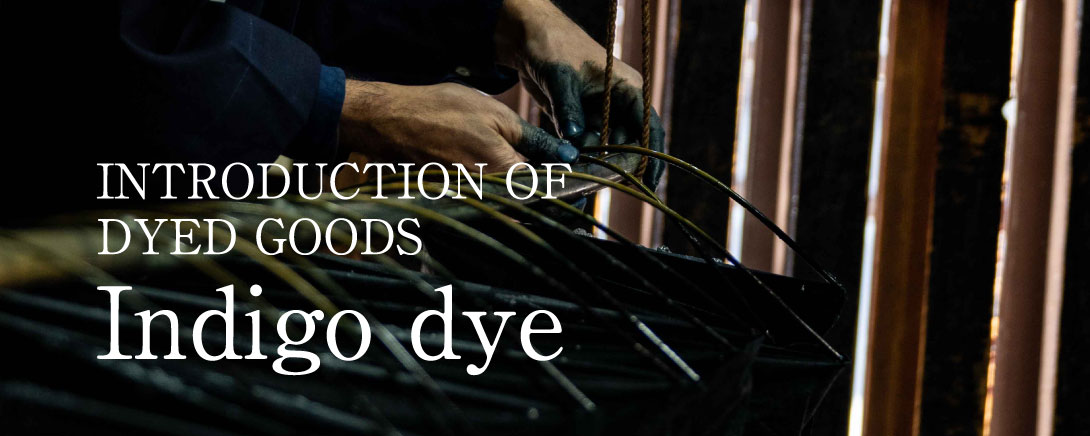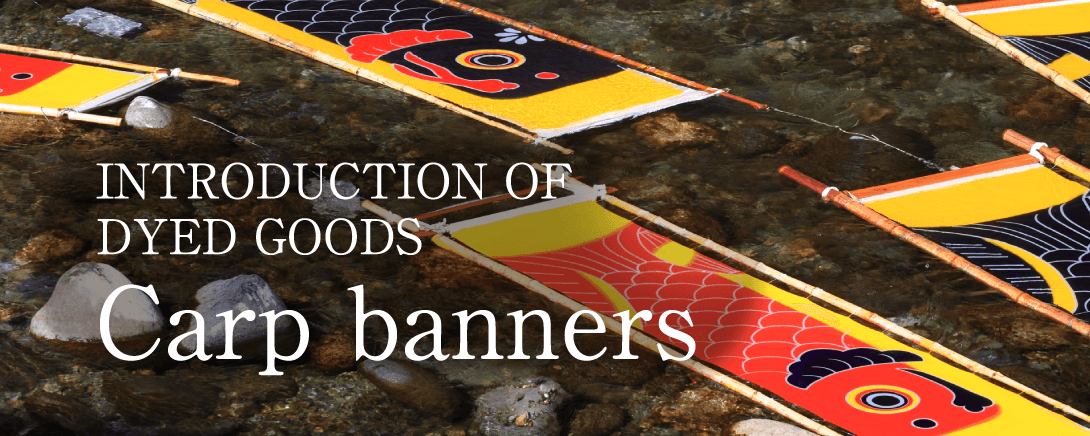Reminders of winter in Gujo
The carp banners
streaming in the cold water



Reminders of winter in Gujo
The carp banners
streaming in the cold water





True indigo dye is created by mixing sukumo, fermented indigo grass of the knotweed family with lye and quicklime, etc., embedding it into soil to brew in a vat. The fermented dye liquid is in a so-called "living state", so it is stirred every day with careful attention paid to the temperature and humidity. The technique which has also been passed down tirelessly since our founding is also one of the appeals of true indigo dyeing. Currently, in addition to seasonal festival items, we also create store signs and tapestries, hanten coats for festivals, bags and Western clothing, stoles, and many other products. We draw each pattern by hand, and in order to dye carefully with natural dyes an artisan performs the dyeing by hand while feeling the texture, creating made-to-order items and individual gifts such as family crests and nametags that always please our customers.




Carp banners are a time-honored custom in Japan that developed in the Edo period. Based on a historical tradition in China saying that "many fish tried to swim up the Toryumon waterfall in order to become dragons, but only the carp were able to", the tradition started as a way of imitating this in human life and became a symbol of the "carp waterfall climbing" seasonal festivals. Originally it was only the largest "black carp" such as the ones featured in Edo period woodblock prints, but from around the Meiji period "red carp" and from the Showa period "young carp" were added and became mainstream. Today with the increase in apartment housing, etc., small carp banners are also enjoyed. Watanabe Dyehouse employs the "kachin dyeing method" which uses squeezed soy bean juice as pigment to carefully paint the patterns such as the fishes' eyes and scales one by one. The "streaming in the cold", where this paste is rinsed off, has become a reminder of winter in Gujo Hachiman, drawing many tourists from Japan and abroad every year.






True indigo dye is created by mixing sukumo, fermented indigo grass of the knotweed family with lye and quicklime, etc., embedding it into soil to brew in a vat. The fermented dye liquid is in a so-called "living state", so it is stirred every day with careful attention paid to the temperature and humidity. The technique which has also been passed down tirelessly since our founding is also one of the appeals of true indigo dyeing. Currently, in addition to seasonal festival items, we also create store signs and tapestries, hanten coats for festivals, bags and Western clothing, stoles, and many other products. We draw each pattern by hand, and in order to dye carefully with natural dyes an artisan performs the dyeing by hand while feeling the texture, creating made-to-order items and individual gifts such as family crests and nametags that always please our customers.






Carp banners are a time-honored custom in Japan that developed in the Edo period. Based on a historical tradition in China saying that "many fish tried to swim up the Toryumon waterfall in order to become dragons, but only the carp were able to", the tradition started as a way of imitating this in human life and became a symbol of the "carp waterfall climbing" seasonal festivals. Originally it was only the largest "black carp" such as the ones featured in Edo period woodblock prints, but from around the Meiji period "red carp" and from the Showa period "young carp" were added and became mainstream. Today with the increase in apartment housing, etc., small carp banners are also enjoyed. Watanabe Dyehouse employs the "kachin dyeing method" which uses squeezed soy bean juice as pigment to carefully paint the patterns such as the fishes' eyes and scales one by one. The "streaming in the cold", where this paste is rinsed off, has become a reminder of winter in Gujo Hachiman, drawing many tourists from Japan and abroad every year.




 Carp banners
Carp banners
 Boy's Festival
Boy's Festival
 Girl's Festival
Girl's Festival
 Tapestry
Tapestry
 Shop Curtain
Shop Curtain
 Canvas Bag
Canvas Bag
 Table Center
Table Center
 Coaster
Coaster
 Hanten / Yukata
Hanten / Yukata
 Clothes / Shawl
Clothes / Shawl
 Other
Other

-If coming by train
25 minute walk from Gujō-Hachiman Station on the Nagaragawa Railway
-If coming from Gujō-Hachiman Station by bus
Gifu Bus highway Hachiman line: 5 minute walk from Joka-machi Plaza bus stop
-If coming by highway bus
Bus and Gifu Bus highway Hachiman line: 5 minute walk from Joka-machi Plaza bus stop
-If coming by car
10 minutes from the Gujo Hachiman interchange on the Tokai-Hokuriku Expressway via the Tomei Expressway/Meishin Expressway Ichinomiya J.C
